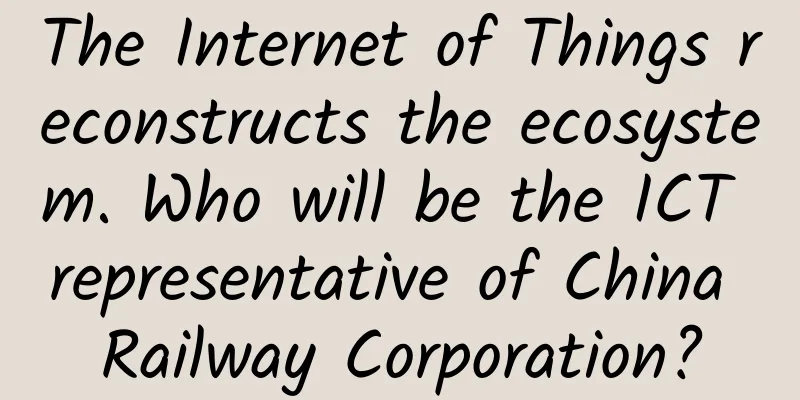The Internet of Things reconstructs the ecosystem. Who will be the ICT representative of China Railway Corporation?

|
When you think of the Internet of Things, what do you think of? GPS, smart meters, connected cars? Or sensors, RFID, or M2M? If it’s the former, you’re an application person; if it’s the latter, you must be a technology person… Neither applications nor technologies can represent the entirety of the Internet of Things, because this is a completely new form: a fully connected world. It is no exaggeration to say that the Internet of Things has the potential to reshape the entire industry. But in fact, the Internet of Things has been talked about for so long, but it has not been able to develop on a large scale. The reason is: connection! ▲The picture above shows 51CTO Yang Wenfei (left) and Huawei's Jiang Wangcheng (right) How hard is it to connect everything? How important is “connectivity” to the Internet of Things? The answer is: very important! The entire ICT field (communication and information technology) was born for connection from the beginning of the industry, so there is no big difficulty in connecting them to each other, it is just the thickness of the connection pipe (bandwidth size). But other equipment, whether it is cars, home appliances, or power equipment, transportation facilities, did not consider the data exchange between each other at the beginning of product positioning and design, so it must be added. However, each product has different uses and characteristics. It is necessary to use connection to open up new value - this involves the difficulty of developing applications, but it is not enough to pay too much for connection - this involves issues of standards, costs and scale. This entanglement is the bottleneck of the advancement of the Internet of Things. It may be easier to explain the problem with an analogy. Everyone knows that high-speed rail has changed the entire railway transportation in China. The "four vertical and four horizontal" plan has now become the "eight vertical and eight horizontal" blueprint, and countless cities want to become high-speed rail cities. Such a huge industrial demand is obviously impossible to be met by the China Railway Corporation alone, so what should we do? The only way is to mobilize all forces and work together. In fact, there is no essential difference between high-speed rail and the Internet of Things. For the real Internet of Everything, connecting pipelines is the foundation and the key: after completing the backbone network, establish clear standards and platforms, do a good job of spare parts, and then use an open mind to create the future with everyone... The key point is, who is the subject of the previous paragraph? If the "subject" of high-speed rail is China Railway Corporation, then who can be the China Railway Corporation in the field of ICT? This role requires the following capabilities: being able to build backbone networks, promote the establishment of standards, make spare parts, and make interfaces... More importantly, you need to have an open mind and work with everyone to build an ecosystem. Now, one company has stepped forward: Huawei. Why Huawei? Why does Huawei want to do the Internet of Things? Jiang Wangcheng, Vice President of Huawei's Product and Solution Marketing and Solution Department, told the author that Huawei began to put forward the idea of paying attention to and promoting the construction of the entire IoT ecosystem from the company's strategic level two or three years ago. The main consideration here is that if the IoT is to succeed, the entire ecosystem industry circle must be able to "play" - this includes upstream applications, downstream equipment, and the pipelines in the middle. Jiang Wangcheng commented, "I think it is an improvement, an inevitable improvement." In 2015, after more than two years of intensive research, Huawei first publicly announced its strategy for the Internet of Things, namely the "1+2+1" strategy. The first "1" refers to an Internet of Things platform that centrally collects, manages, and processes data and then opens it to partners and industries. Industry partners can develop applications based on this platform; "2" refers to two network access methods to ensure the connection pipeline; the last "1" is Huawei's newly launched lightweight Internet of Things operating system Huawei LiteOS - Jiang Wangcheng added that it actually also includes Huawei's upcoming chips and modules. Huawei publicly announced its expectations: to build an Internet of Things ecosystem for industry application scenarios, and to work with upstream and downstream partners to jointly create Internet of Things industry solutions - it can be said that Huawei expects to use the Internet of Things to reconstruct the entire industry system, including operators and industry users! But at the same time, Huawei's own system was also forced to restructure. Before this, Huawei was only involved in the supply chain, not the ecological chain. It was like a construction unit responsible for railway track construction. Now it is asked to be responsible for the entire railway and related industry ecology. This span is not small. How does Huawei determine its position in this ecological chain? Jiang Wangcheng said that first of all, Huawei's role in the entire ecological chain is very critical. "To get rich, you must first build roads." Without this platform, other work will only stagnate. But at the same time, he also emphasized that Huawei's work has clear boundaries: "Huawei certainly cannot take on everything, and we can't do it. Our core strategy is to focus on pipelines. The boundaries of what to do and what not to do in the entire ecological chain of the Internet of Things are very clear. This way, our partners will not worry too much." Can Huawei succeed? It has been more than a year since Huawei announced its IoT strategy. How is Huawei's progress? What kind of results will they achieve? In response to my question, Jiang Wangcheng did not answer me directly, but he said that the overall progress is basically proceeding according to the planned schedule, and the progress in all aspects is obvious. First, Huawei has made significant progress in the equipment and basic platform. In addition to the already released Huawei LiteOS open source IoT operating system, the industry's first commercially available narrowband cellular IoT (NB-IoT) chip will be released in September and will begin small-scale commercial use, and will be put into large-scale commercial use by the end of the year. It should be noted that the 3GPP R13 protocol corresponding to NB-IoT was just frozen on June 16, which also marks the emergence of a global standard for the most important protocol of the Internet of Things. In fact, Jiang Wangcheng said that the release of Huawei's chip was delayed by one quarter than planned, precisely because it was waiting for the final freezing of this standard, and the related chips of other companies in the industry were also later than Huawei. On the application side, Huawei's software development tool platform SoftRadio suite will also be officially released in September. With this platform, users can easily connect to the remote development experimental environment provided by Huawei no matter where they are, and achieve remote docking test certification - all work is done in the cloud. To this end, Huawei has specially established seven Open Labs around the world, among which the domestic laboratory was jointly established with operators such as China Mobile, China Unicom, China Telecom, and the Ministry of Industry and Information Technology, providing developers with a free 24/7 cloud-based laboratory environment. Huawei not only provides software and hardware platforms, but also spares no effort in cultivating industry developers. In addition to the Open Lab and public cloud services mentioned above, Huawei also attracts developers to understand and participate in IoT development through activities such as developer competitions, and actively helps developers improve their creativity and development level. In the just-concluded "2016 Huawei Developer Competition", the number of projects using Huawei's IoT platform was the largest among the top 20 projects, among which the "Smart Water" project won the first prize. In addition to developers, Huawei is also actively promoting the development of the industry. In March 2016, Huawei released the industry's first multi-level intelligent control lighting IoT solution at the CeBIT 2016 conference, which connects urban lighting street lamps to the IoT network and can directly manage the status of each block and each street lamp. If each project is a street lamp, then we will have to wait and see when Huawei's IoT ecosystem can light up the entire block. |
>>: How can technicians get rid of the anxiety in the era of transplanting everything?
Recommend
The more sour the fruit, the higher the vitamin C content? If you want to supplement vitamin C, read this quickly
"The more sour the fruit tastes, the higher ...
How to find the best selling point in 15 minutes? This is what the boss thinks...
Have you ever had this experience , your boss cal...
Xiaomi responds to being banned in India (with original text)
Xiaomi responds to being banned in India (with or...
2015 App Operation and Promotion Strategy (Full Version)
The basic tone of the APP operation and promotion...
10 secrets of why iPhone is so expensive, let Apple continue to fly for a while
Apple's biggest adventure was completed last ...
Precautions for fresh Cordyceps sinensis
May and June every year are the fresh Cordyceps s...
Is it expensive to customize Zhoukou’s liquor and beverage mini program? Zhoukou wine and beverage applet customization cost and process
There is no fixed price for the customization of ...
How does Zhurong cope with the winter on Mars? The engineering team explains
According to the Lunar Exploration and Space Engi...
As an operator, how to quickly build a systematic knowledge system
Why do we need a systematic system? Because opera...
Gynecological master or devil from hell? The Dr. Sims you don’t know!
Get the nine-valent vaccine, do HPV screening, TC...
4 tips for attracting traffic, getting high likes, ranking, and making money on Zhihu!
Zhihu, a place with high precision traffic 1. Why...
Talking about Snakes in the Year of the Snake | The Year of the Snake is here, dragons and snakes are passed down from generation to generation, let’s take a look at the story of the giant snake!
Warning: This article contains multiple photos of...
How to activate a “professional account” on Xiaohongshu? Here is a guide for you to start
Today, Xiaohongshu adjusted its account system an...
Zhang Peichao, the leader of the Young Turks: A psychotherapy course specifically for Chinese people (20 micro-courses) Audio course
Zhang Peichao, the leader of the Young Turks: A p...
These drugs are no longer available and have been recalled! Check if you have any
Notice from the State Drug Administration on 22 b...









